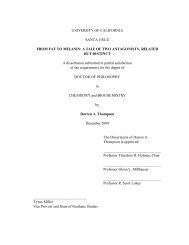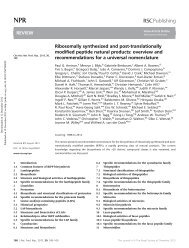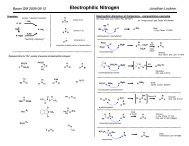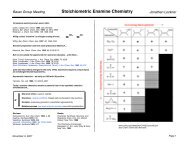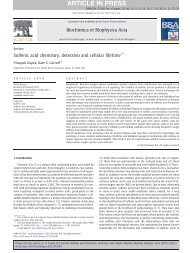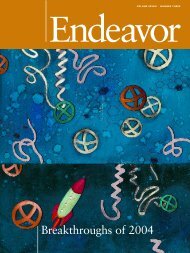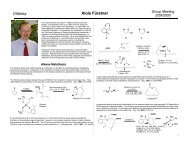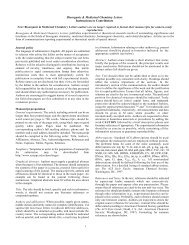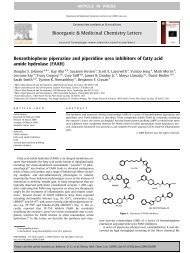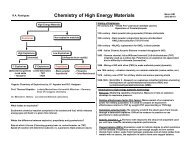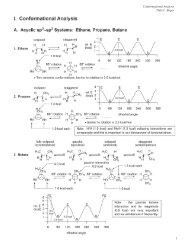The biosynthetic gene cluster for the antitumor drug bleomycin from ...
The biosynthetic gene cluster for the antitumor drug bleomycin from ...
The biosynthetic gene cluster for the antitumor drug bleomycin from ...
You also want an ePaper? Increase the reach of your titles
YUMPU automatically turns print PDFs into web optimized ePapers that Google loves.
Research Paper Bleomycin <strong>biosyn<strong>the</strong>tic</strong> <strong>gene</strong> <strong>cluster</strong> Du et al. 635<br />
Figure 8. Proposed pathways <strong>for</strong> BLM megasyn<strong>the</strong>tase-templated assembly of <strong>the</strong> BLM aglycone. (A) Early steps of BLM biosyn<strong>the</strong>sis,<br />
supported by <strong>the</strong> isolation of P-3. (B) Steps <strong>for</strong> <strong>the</strong> biosyn<strong>the</strong>sis of <strong>the</strong> polyketide moiety of BLM, supported by <strong>the</strong> isolation of (17RS)-P-<br />
3K and (17R)-P-4. (C) Steps <strong>for</strong> <strong>the</strong> biosyn<strong>the</strong>sis of <strong>the</strong> bithiazole moiety of BLM, supported by <strong>the</strong> isolation of P-6m. Three-letter amino<br />
acid designations were used. NRPS and PKS domains are abbreviated as follows: A, adenylation; ACP, acyl carrier protein; AL, acyl CoA<br />
ligase; AT, acyl transferase; C and CP, condensation; Cy, condensation/cyclization; KR, ketoreductase; KS, ketoacyl synthase; MT,<br />
methyltransferase; Ox, oxidation; PCP, peptidyl carrier protein. A subscript number designates <strong>the</strong> Blm NRPS module, to which <strong>the</strong> domain<br />
belongs. MCoA, malonyl CoA; `NH 2 ', unspeci¢ed ammonia donor.<br />
syringomycin <strong>cluster</strong> [78] showed no differences to any<br />
o<strong>the</strong>r typical NRPS modules.<br />
<strong>The</strong> syn<strong>the</strong>sis of <strong>the</strong> BLM peptide^polyketide backbone<br />
could start by a conjugate addition between <strong>the</strong> Ser-derived<br />
Dha on NRPS-4 module and Asn on NRPS-3 module,<br />
followed by an aminolysis to cleave <strong>the</strong> Ser^Asn adduct<br />
off <strong>the</strong> Blm megasyn<strong>the</strong>tase to furnish <strong>the</strong> unusual L-<br />
aminoalaninamide moiety (Figure 8A) (A conjugated addition<br />
to a Dha has also been proposed <strong>for</strong> <strong>the</strong> biosyn<strong>the</strong>sis<br />
of <strong>the</strong> pyridine moiety of <strong>the</strong> peptide antibiotic GE2270A<br />
[83].) <strong>The</strong> <strong>for</strong>mer reaction could be catalyzed by <strong>the</strong> C<br />
domain of NRPS-3 that apparently is nonfunctional <strong>for</strong><br />
normal transpeptidation due to <strong>the</strong> lack of both His residues<br />
in <strong>the</strong> conserved HHxxxDG active site (Figure 3C)<br />
[39], and <strong>the</strong> latter reaction could be catalyzed by <strong>the</strong> ALlike<br />
domain of <strong>the</strong> NRPS-5 starter module in a process that<br />
resembles <strong>the</strong> AL-catalyzed syn<strong>the</strong>sis of acyl CoA <strong>from</strong><br />
carboxylic acid but in <strong>the</strong> reverse direction in <strong>the</strong> presence<br />
of an amino donor (Figure 3E) [41]. Elongation resumes by



